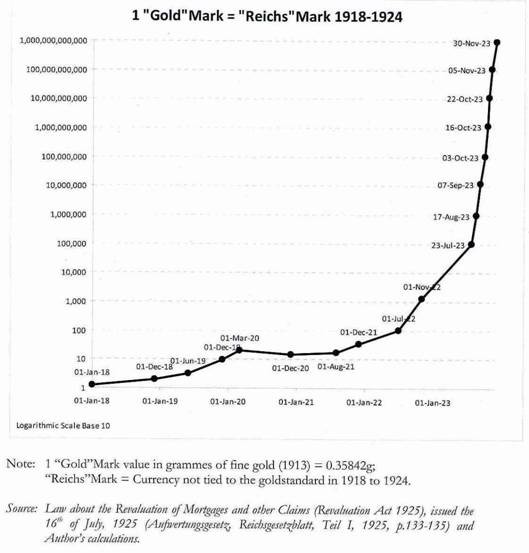How Fiat Dies Positive Feedback Theory of Hyperinflation
Post on: 10 Апрель, 2015 No Comment

Saturday, August 16, 2014
Positive Feedback Theory of Hyperinflation
I contend that Hyperinflation is a set of Positive Feedback loops. There are many different ways to describe these loops. One is that after a government has a large debt and a large deficit that it can get into a loop where the more people stop rolling over their bonds the more the central bank has to make new money and buy bonds, so the government has cash to operate. But the more new money it makes the more inflation there is and the less anyone wants to hold bonds. So the phenomenon can feed on itself and grow. There are more loops, but this gives you one way of explaining one part of hyperinflation.
In comments on the previous post Tom said this was circular reasoning. A good example of circular reasoning is:
The Bible is the Word of God because God tells us it is. in the Bible.
In the above the reasoning is circular. If the Bible is the word of God, then in the Bible God tells you so. But if it was not the word of God, then God did not say it was. It is not a good logical argument.
In a positive feedback phenomenon there is a feedback loop made up of real things. It is not just circular reasoning. You can watch and measure what is going on in the real world. You can see how one part pushes another, and that pushes so that it comes back around magnifying the phenomenon.
I think it will help readers to understand my examples of positive feedback loops below, and their common characteristics, before looking at hyperinflation:
Avalanche
A bunch of snow can be sitting on a steep mountain so that it is almost ready to slide. If something, say a little rabbit, then causes some of it to move, then that can cause more, which causes more, etc. A small trigger can set off a chain reaction that causes a huge amount of snow to slide down the mountain.
Forest Fire
If there is a high enough density of burnable material in the forest, then a single ignition can set off a chain reaction where a whole forest burns down.
Earthquake
There are two plates of earth touching each other. But they are slowly pushing past each other. For many years the ground just slightly flexes under the strain. However, at some point part of the ground rips. After the first part rips the strain is too much for the next part and it also rips. This chain reaction continues down the fault line often for miles.
Volcano
Water is mixed in the lava but under such pressure that it does not turn into steam even though it is very hot. However, if some of the lava on top breaks through the earth dam around the lava and spills out then there is less pressure on the lava below. If there is enough less pressure that the water turns to steam it can throw off the top of the lava. This then reduces the pressure on the lava further below which then also releases steam. This chain reaction can continue till huge quantities of lava are thrown into the air as volcanic ash.
Hurricane
If the over 82 degrees F and the ocean is hotter than the air then it can warm up the air as wind blows over he ocean. The hotter air rises and makes more wind. The faster the wind goes the more heat is transferred from the ocean to the air.
The more heat there is in the air, the faster the wind blows. So you get a positive feedback loop leading to really strong winds.
Ice Age
The more snow the more sunlight is reflected back into space and the colder it gets. The colder it gets the more snow accumulates. You can get a positive feedback loop where much of the Earth ends up covered with snow.
Not only is there a feedback loop as the snow advances, there is also one as it recedes. The warmer it gets the less land is covered with snow. The less land covered with snow, the warmer it gets. So the snow marches forward as far as it can and then it marches backward.
Domino Avalanche
Set up dominoes so that the first one will knock over 2 others, and each of those will knock over 2 more, etc. So with each time increment there will be twice as many dominoes falling. One little push can then cause many dominoes to fall over.
Landslide
This is much like an avalanche but earth instead of snow. There is a bunch of earth on a slope and once some of it starts to break more and more follows till there is lots of earth sliding down.
Earth Dam Failure

If a little bit of water goes over or through an earth dam it can erode a bit of the dam. This makes for a bigger path for water and so water flows faster. This then removes earth faster and so water flows faster and faster. With this positive feedback loop, an earth dam can be quickly destroyed.
Snowball
With the right hill and snow you can start a small snowball rolling down the hill and it will grow and grow and grow.
Ping Pong Balls and Mousetraps
If you put a bunch of ping pong balls on set mousetraps and trigger one, you can get a chain reaction. It only takes a small amount of energy to trigger a mousetrap and then the ball flies off with lots of energy to bounce around and hit others. This is not part of nature, but the video is fun and does illustrate the idea of a chain reaction.
Common Characteristics for these and Hyperinflation
In each case there is some set up condition. Something that has to be in place for a growing chain reaction to be possible. Under the right conditions, a small thing can set off a large chain reaction. Once the chain reaction starts it is very hard to stop it. Eventually it will burn itself out and stop on its own. Under the proper conditions, we say there is a risk of this chain reaction. Even if the reaction has not yet happened, an expert can still see that there is a risk of it happening.
Because a small input can move things to another state, the initial state can be viewed as unstable. We also tend to see positive feedback loops as causing destruction.
The natural positive feedback loops above, except for the Ice Age, have some form of stored energy which is used up in powering the chain reaction. This can be potential energy, chemical energy, or heat energy. I think the equivalent in hyperinflation is the value of the money being used up.
The best prediction you can give for most of these is a high risk and not an exact date. Earthquakes, volcanoes, forest fires, avalanches, etc. are things where an expert can tell when there is a danger, but still not be able to say exactly when the trigger will be. I think it is the same with hyperinflation.
It would make as much sense to accuse each of these real world phenomenon of circular reasoning as it does to claim this of my explanation of hyperinflation.
Now on to Hyperinflation
Once you understand the above examples of positive feedback loops you should then read the different ways of explaining the positive feedback loops in hyperinflation.














